Project Description
Since 2003, Lumos has provided project scoping including roadway condition analysis which includes existing surface evaluations, determination of asphalt cracks for width and depth; asphalt patching requirements; videoing using GoPro cameras for use during design of existing striping and patch lay-out along with treatment recommendations as part of the Washoe County RTC’s Annual Maintenance Program. Our team’s approach to this project is a coordinated effort with all parties involved including the Washoe County RTC, City of Reno, City of Sparks, Washoe County and the Nevada Department of Transportation. Upon completion of the project scoping, Lumos identifies roads that need to be completed within that year and ones that could be delayed. Those lists are forwarded to their respective agencies for review, comment and acceptance. Many times, a field meeting will be required to meet face to face to achieve everyone’s goals. Once the final list is approved by all parties, a determination of patching limits in the field is completed and once again coordinated with all agencies involved to verify Lumos’ patching limits. Once approved, Lumos maps the areas for patching, crack seal and slurry quantities and utility valves by utilizing GPS/GIS technology.

